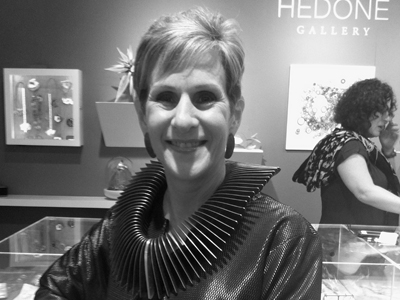AJF just announced this year’s five 2018 Artist Award finalists: Karin Roy Andersson, Bifei Cao, Corrina Goutos, Aurélie Guillaume, and Jelizaveta Suska. Their work represents a group of outstanding pieces of contemporary jewelry.
For this, the 16th annual AJF Artist Award, the jurors were Swedish collector Inger Wästberg, Australian curator Su san Cohn, and American artist Lynn Batchelder, the winner of the 2016 Artist Award. The jurors met in December and selected the finalists for the 2018 AJF Artist Award from more than 100 applicants. Their choices were based on originality, depth of concept, and quality of craftsmanship. These artists were all 35 years of age or younger at the time of the application deadline. The winner will be announced during Munich Jewellery Week, in March. During the fair, the work of all five finalists will be on exhibit at Platina’s booth in the International Trade Fair hall in Munich, in the Frame area surrounding Schmuck.
AJF asked the finalists to tell us a bit about their backgrounds, the work they submitted for the competition, and their thoughts on the future of the art jewelry field. Here’s our interview with Corrina Goutos. It’s the third of the five interviews with all the artists.
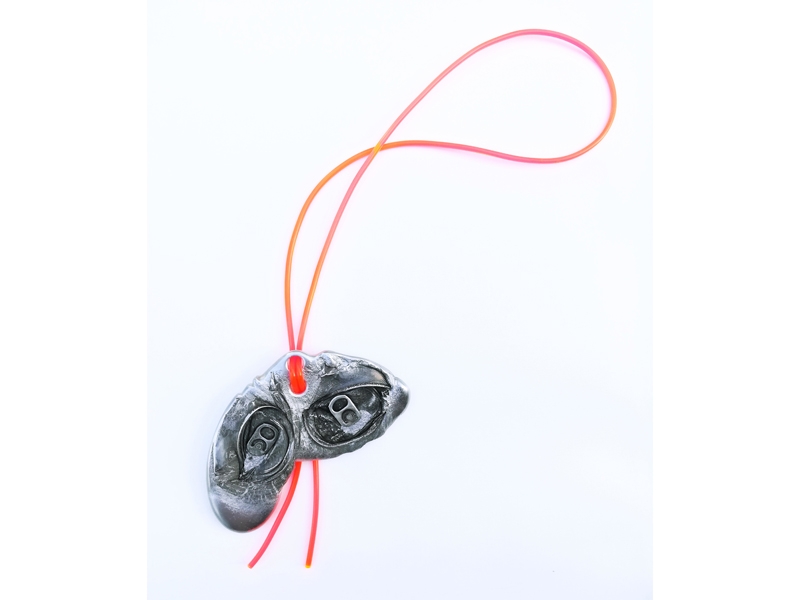
Bonnie Levine: Congratulations on being one of the five finalists of the 2018 Artist Award competition—that’s quite an accomplishment! Please introduce yourself to our readers. How did you become interested in jewelry, and what inspires your work?
Corrina Goutos: First off, I’d just like to extend a huge thank you to the fabulous team at AJF and all of its supporters for this huge honor.
In my hometown of Albany, NY, US, at age six, I declared that I was going to be an artist. After years of dabbling in fine arts, I became exposed to Mexican folk art for the first time, and I became interested in using things from the household. I rummaged through our recycling bins and started collecting interesting cans from the Asian market and turning the characters and images into earrings. At age 14, I started doing local craft fairs selling collaged tin can jewelry. My paintings started revolving around advertising icons and depicting them in religious imagery. I believe my immigrant grandmother, who had taught me that everything worthwhile in life is done with your own two hands and that money plays no role in happiness, gave me a very sour taste when it came to capitalism and mass consumption. Since she died when I was seven, I suppose I had my artistic agenda in stone—I just didn’t know it yet.
I studied Jewelry and Objects at the Savannah College of Art and Design (SCAD) in Georgia, USA, and affirmed jewelry as my dream medium. Following my passion for handcraft, I then moved to Germany, where my critical inspirations took on a playful flair. The vibrant trash-filled streets of Berlin were full of characters, and I saw their humor, passion for life, and “c’est la vie” attitude even in the waste they littered. I started to curate and document intriguing waste “moments” as a form of adornment that the city wears. These photographs inspire my work quite directly today, as do social media and cultural trends. To spare you the life story, I’ve been making jewelry out of cans since I had motor skills.

What does being a finalist mean for you? Do you think it will influence you going forward?
Corrina Goutos: It means the world to me—it means the fusion of two worlds and finally having a platform for sharing the integral second half of my work, which too rarely lands in the same place as the jewels: the concept. Many appreciate the aesthetic aspects of the work only, and that’s okay! But when I have a client who is drawn to a jewel and has more questions than answers for it, then I am most excited. It’s a pinnacle moment when the same viewer eagerly tries on the jewel, as well as the idea that led to its creation. I think being a finalist for AJF’s Artist Award will expose me to an audience asking the kinds of questions I’m prepared to answer.

Tell us about the work you submitted for the competition.
Corrina Goutos: This collection is the result of a YouTube binge and a strict several-months-long ban I gave myself from completing a piece of work last spring. I felt my studio practice had become very cramped and the work had lost the spontaneity I enjoy so much. My YouTube feed inspired new connections when my personal channels—pertaining to package-free lifestyles and dumpster diving—and my studio’s technical research channels—pertaining to backyard science experiments and model-making—landed side by side.
Pairing these with a lingering guilt about extracting precious minerals from the Earth, I looked to my own property to find alternatives. As I recently began sharing the property with an auto mechanic, I was quite literally sitting on a goldmine. I started hacking the pile of scrap metal piled next to my studio into pieces—starting with aluminum car rims. I constructed a foundry and started recasting the pieces. It was a rash process involving lightning decision-making and acceptance that almost every piece was going to be immediately thrown back into the furnace before it even cooled. I had found my fix and relinquished my need to control. Months later I had a bench full of potential and started to bring the experiments to completion. The result is a careless, spontaneous aesthetic that breaks all the casting rules and yet required a diverse range of my background skills.
I think the work speaks true to the current generation and captures the frustration we (the concerned minority) feel in tackling the problem of global warming seemingly single-handedly. The works recognize the allure of self-indulgence and the bliss of short-term and/or narcissistic thinking. They’re an ode to a generation of indifferent indulgence, to the modern consumer and his/her many short-lived personalities. Acting as an archetype of a souvenir—the works make a disposable culture permanent, that it may be considered a second longer. Making trash into jewelry, to be worn proudly on the body, brings an ownership to the object, an intimacy most aren’t ready for. My collection Foul Play is the picture of youthful, ignorant bliss, and the sustenance of the era to follow: Art jewelry almost entirely crafted out of human waste.
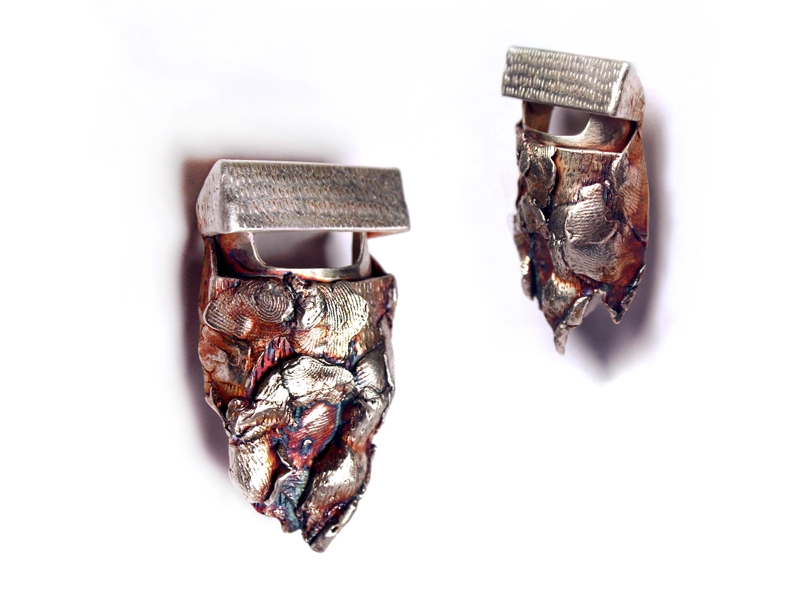
What excites you about the art jewelry field?
Corrina Goutos: Art jewelry is one of the most powerful mediums in the world. A great jewel has the ability to start a massive snowball effect; an accumulation of memories and significances that one human, or generations of humans, assign to it. It fulfills our need for permanence in a fast world—commemorates a time, place, person, or moment—and puts that thing right up against our skin, triggering intimate memories of nurture and affection. Unlike the most stunning painting, it isn’t off limits, it’s not too adult—art jewelry encourages us to stay kids and fulfill our desire to touch. And furthermore to fulfill our youthful urge to transform ourselves, to play dress-up, to experience life differently for a day.
I think nearly all art jewelers are grown kids, at least the ones I know. Together, we’re part of a revolution in handcraft: a league of highly intelligent, diversely skilled, and knowledgeable makers who can vocalize complex ideas, from the morally critical to the emotionally freeing—in an object. Artisans who are furthering an ancient craft by infusing it with contemporary subject matter, materials, and experimental techniques, and even if in the process we break half the rules, we pay homage to the generations of makers we’ve succeeded.
And finally, my favorite part of the making process is the adoption—when the artist has to stop curating and the jewel takes on a new context; when the wild card character of the wearer and the jewel come together to start their journey.

Any frustrations that you see or have experienced?
Corrina Goutos: I’ve had several major collectors and gallerists disregard my work or label it commercial, and therefore not art jewelry, solely because the works were primarily metal, or one or two were highly polished. It was frustrating to someone like me, who is quite critical of the jewelry industry, not to be given a moment’s attention to explain my material choices, which were well considered in adherence to the concept. Although I’m a huge fan of alternative materials, they’re not synonymous with art jewelry, which has no such restrictions. Metal has infinite retransformation possibilities that make it an incredibly tantalizing material, and I think repurposing our goldsmith backgrounds to discover new techniques is a springboard of inspiration for many makers. Although we should all continue full-heartedly with our own material exploration journey, metal and jewelry will always be, and should be, a match made in heaven! While I find it hard to imagine this is a widespread attitude, most certainly not amongst AJF, I have received this feedback more than once, to my surprise. Oh, and I don’t have a problem with blurring the line between art and “wearable” jewelry either; it’s all relative in the end.
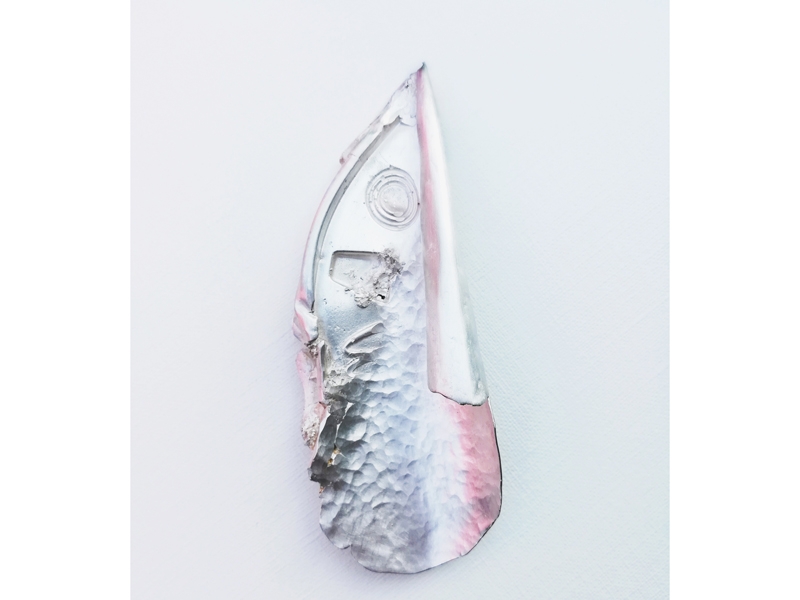
Where do you think the art jewelry field is going? Are there new and exciting trends that you see?
Corrina Goutos: The jewelry field is leaving the studio! I’m excited to see more multimedia disciplines, more collaborations with individuals outside of the field and more experimental and participatory projects getting the community involved. I think globalization is exposing more people to the wonders of art jewelry, and they’re intrigued!
We saw lots of politics and jewelry in Munich last year, as well as collaborations with photographers, filmmakers, and even with digital tools. Technology is facilitating collaborations from makers who have never met, via FaceTime and the post. It’s a really exciting time in the field. I love seeing these new approaches and am definitely dabbling in some on the side, too!
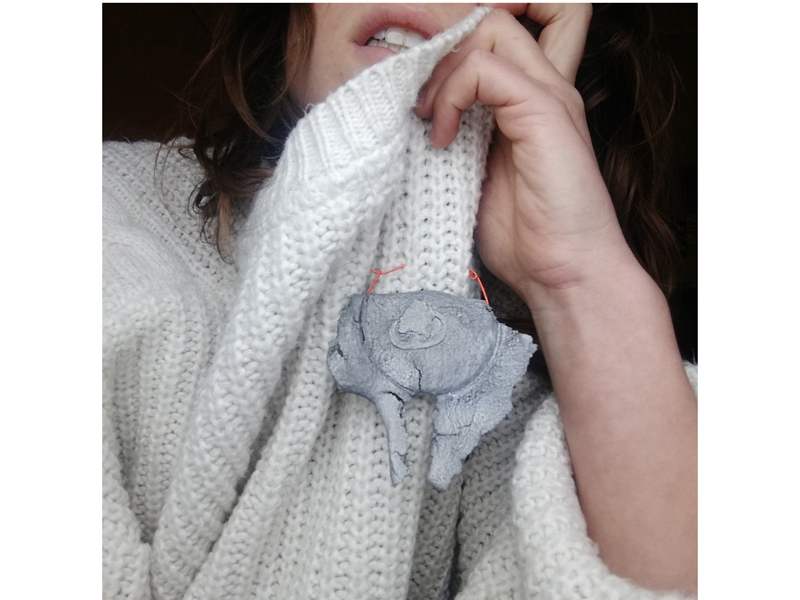
If you could write a master plan for your practice, where would you like to be five years from now?
Corrina Goutos: In terms of techniques, it’s hard for me to say what my working style will be in five years. My material journey and making mood often vary—from meditative, repetitive techniques to crude attacks on the materials. The constant remains my aesthetic, and of course the core of my values; to them I would like to be even truer. To have an exemplary green studio practice in which I sustainably produce gallery-quality art crafted from waste materials would be my dream. I hope the pieces are cherished and handed down from generation to generation. I’m also interested in facilitating more installation and sculpture works in harmony with jewelry, to be found in the context of both art and art jewelry galleries.
In addition, I’m developing several crash course workshops for complete beginners that incorporate jewelry industry education and exposure to the thinking of the world of art jewelry from the get-go. Finally, I’m very excited to collaborate further with makers in different fields and backgrounds, especially to fuse technology and handwork in individual pieces.
Congratulations again! Thank you very much.

